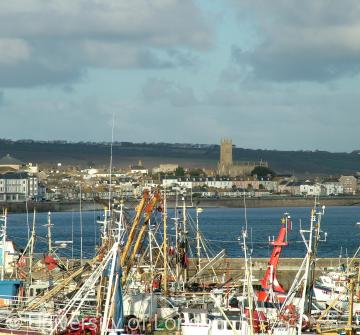Coastal Communities

The coastline of England is extremely varied, from the rocky and often inhospitable coasts of counties like Cornwall to the vast marshlands and muddy creeks of counties like Essex. These contrasts are reflected in the numbers, size and form of coastal settlements, which ranged from small isolated outposts for fishermen to major ports like Portsmouth, Bristol and Liverpool. Fundamental to all were either a protected harbour or anchorage on the open coast or access to the sea via a river estuary or creek where quays or landing places were established. Sometimes the major settlement was sited some way inland and was linked by a road leading to a separate ‘quay’ on the more isolated coast, known as a ‘hythe’ in East Anglia.
Most coastal villages and small ports relied on economic activities that distinguished them from their inland counterparts. The local population frequently made its living directly from the sea through fishing, including fixed fish traps (weirs), in-shore and off-shore netting and trawling, crabbing and shellfish collection. An example demonstrating the ancient origin of such activities are the remains of massive fish weirs of Roman, Anglo-Saxon, and medieval date found in the Severn, Thames and other estuaries. Even the smallest coastal settlement usually had a boatyard, and the larger the settlement the more significant and specialised its shipbuilding capability and dockyards could become. Another distinctive coastal economic activity recorded from Iron Age and Roman times was the production of salt by evaporation in salt-pans, producing the famous ‘Red Hills’ of burnt pottery vessels along the former coastline.
The sea was a major highway for both communication and trade, and was especially important before the development of the railways and the modern road network. It connected other coastal communities directly, and, via river estuaries, the majority of inland cities and counties too. Much trade was in agricultural produce which could be loaded onto small craft, and brought to market via river, estuary and sea. As the city of London grew it drew sustenance not only from the surrounding counties and the highway that was the Thames, and but also from the whole of the East Coast. Coastal settlements and ports were also the only way of direct contact with the Continent and further afield, for trade in goods, the migration of people, diplomatic communications and cultural exchange. That is until air travel and the Channel Tunnel!
The coastal location and distinctive economic activities created different forms of communities and social organisation. A well-known example are the ‘gut girls’ of the Eastern England who followed the herring fleets down the coast to towns like Yarmouth and Ipswich preparing the catch landed from the boats manned by men. Certain major ports developed as important naval bases and naval dockyards, such as Chatham on the Medway and Portsmouth in the Solent. As seaside leisure activities grew in importance so new types of coastal settlement sprang up from the 18th century in the form of specialised resorts providing accommodation and entertainment. Some resorts started as expansions or conversions of existing settlements but others were entirely new creations, and they varied enormously in their ‘social tone’ from the popular and brash Blackpool and Southend to the more genteel and select Sidmouth and Frinton.
Serious threats to the existence of some coastal settlements derive from coastal erosion, long-shore drift and the silting-up of river estuaries. In some cases the natural processes have been affected or exacerbated by human action, through the depletion of protective beaches by the removal and sale of sand and gravel, the loss of protective salt marsh from reclamation, or by the erection of sea defences that have only served to shift problems further down the coastline. On occasion whole settlements have been swept away and largely destroyed. One notable example is Dunwich in Suffolk, now a village but formerly a bustling medieval port with eight churches and five monasteries or hospitals. Elsewhere settlements have been left stranded inland when the sea has retreated, or settlements have followed the shoreline and been re-established on new sites from where former activities can continue. In some cases an attempt is now being made to protect the coast in ways more sensitive to nature, for example in the recreation of salt-marsh through ‘managed retreat’. This has an important side effect through protecting and re-creating significant wildlife habitats especially for migratory birds.
Coastal settlements and harbours were, of course, also potential entry points for unwanted visitors, and have thus been heavily defended. Among early defences still standing are some of the Roman forts of the Saxon Shore at places like Pevensey in Sussex. The sites of many medieval fortresses lay on the coast, for their effective defensive positions, ease of supply and their dominance of coastal communications. Local communities also had responsibility for maintaining warning systems using beacons, such as that famously used to warn of the Spanish Armada in 1588. The power of coastal fortresses expanded from Tudor times with the further development of gunpowder artillery, leading to the creation of coastal gun forts and batteries under Henry VIII and later monarchs. There was now greater potential for denying enemy ships entry to estuaries and harbours, and also for protecting against landings on vulnerable beaches. Further defences were added in all the major conflicts that followed, including the Dutch wars of the 17th century, the Napoleonic wars, and the two World Wars of the 20th century. For certain periods many coastal towns and ports had very significant garrisons.

